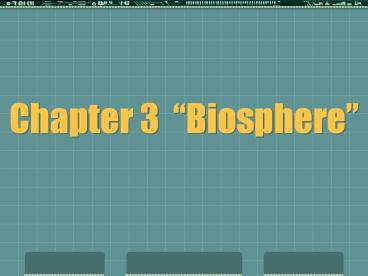Chapter 3 Biosphere - PowerPoint PPT Presentation
1 / 24
Title:
Chapter 3 Biosphere
Description:
Chapter 3 Biosphere 3-1 What is Ecology? Ecology - study of how the living and nonliving world interacts. Organisms and their environment Biosphere portions ... – PowerPoint PPT presentation
Number of Views:192
Avg rating:3.0/5.0
Title: Chapter 3 Biosphere
1
Chapter 3 Biosphere
2
3-1 What is Ecology?
- Ecology - study of how the living and nonliving
world interacts. - Organisms and their environment
- Biosphere portions of the planet where all life
exists - (land, water, and air)
3
Biological Organization
- Individual a single organism of a species
- Population group of individuals of the same
species living together in a specific area
4
Biological Organization
- Community different populations living together
in a specific area
- Ecosystem - collection of all nonliving and
living organisms living in a specific place
5
Biological Organization
- Biome group of ecosystems that have similar
climates and communities
- Biosphere - portions of the planet where all life
exists - (land, water, and air)
6
Methods of study
- Observation using the 5 senses and recording
our findings
- Experimentation testing the hypothesis done in
natural or unnatural (labs) environments
- Modeling done when the event or object being
studies is too large or too far from us.
7
Section 3-1 Assessment
- 1. List the six different levels of organization
ecologists use to study the environment.
- 2. Describe the three basic methods of ecological
research
8
3-2 Energy Flow
- The main energy source for life on Earth is the
sun. - How do you and I use the suns energy?
- Those organisms that directly use the suns light
to produce their own food are called Autotrophs.
- Producers another name for autotrophs on Earth
9
Energy Flow
- Not all autotrophs use the suns energy. Some
rely on other inorganic chemical compounds.
- Those organisms that do get their energy from the
sun carry out a common process to use light
energy to carry out chemical rxns.
- These are called chemoautotrophs
10
Photosynthesis
- Chemical rxn that converts carbon dioxide and
water into oxygen and sugars
- 6CO2 6H2O C6H12O6 6O2
- carbon water light
sugar oxygen - dioxide energy
11
Chemosynthesis
- Process used by some autotrophs, they use
chemical energy to produce carbohydrates - Similar to photosynthesis
12
Consumers
- Cannot harness energy directly from the
environment as autotrophs do, instead they
acquire energy from other organisms.
- Heterotrophs organisms that rely on other
organisms for their energy and food supply
13
Types of Consumers
- Herbivores obtain energy by eating only plants
(cattle)
- Carnivores obtain energy by eating other
animals / meat (wolves)
- Omnivores obtain energy by eating both plant
and animals (humans)
14
Types of Consumers
- Detritivores feed on plant and animal remains
and other dead matter (earthworms)
- Decomposers break down organic matter
(bacteria)
15
Levels of Consumers
- Trophic Level A step in a food chain or food web
- Primary Consumer These individuals feed on
producers herbivores
- Secondary Consumer These individuals feed on
primary consumers carnivores
- Tertiary These individuals feed on secondary
consumers carnivores
16
Feeding Relationships
- Energy flows through an ecosystem in one
direction, it is not a cycle. It begins with the
sun, then producers, and on to the consumers.
- A diagram showing a single pathway of how energy
travels through the ecosystem is called a food
chain.
A diagram showing multiple pathways of how energy
travels through the ecosystem is called a food
web.
17
Ecological Pyramids
- Shows the relative amounts of matter in each
trophic level in the food chain / web
- Energy Pyramid only 10 of the energy stored in
one trophic level is passed on to the next level
the remaining 90 is used or lost as heat.
18
Ecological Pyramids
- Biomass Pyramid shows the total amount of
living tissue within a given trophic level
represents the amount of potential food available
for each trophic level.
- Numbers Pyramid based on the number of
individual organisms at each trophic level shape
is not always a pyramid
19
3-2 Section Review
- 1. What is the main form of energy that powers
living things?
- 2. Briefly describe the flow of energy among
organisms in an ecosystem.
- 3. What proportion of energy is transferred from
one trophic level to the next?
20
3-3 Cycles
- Unlike energy, matter is recycled within the
ecosystem
- Biogeochemical cycles show how elements,
chemicals, and other forms of matter are passed
from from one organism to another in the
ecosystem.
- Connects biological, geological, and chemical
aspects of the biosphere
21
Water cycle
- Evaporation process by which water changes from
liquid to gas form
- Condensation process by which water changes
from gas to liquid form
- Transpiration process by water evaporates from
the leaves of plants
22
Water cycle
- When it rains, snows, etc. (precipitation) the
water will - Runoff to ponds/lakes
- Soak in and become
- Groundwater
- Taken up by roots and transpire
- Evaporate
23
Nutrient cycles
- Carbon
- Nitrogen
24
Nutrient Limitation
- Primary productivity
- Limiting agent































